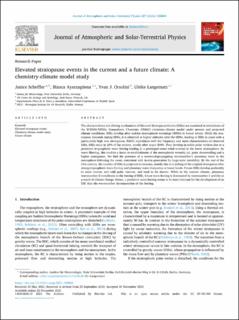| dc.contributor.author | Scheffler, Janice | |
| dc.contributor.author | Ayarzagüena, Blanca | |
| dc.contributor.author | Orsolini, Yvan J. | |
| dc.contributor.author | Langematz, Ulrike | |
| dc.date.accessioned | 2021-12-08T08:49:19Z | |
| dc.date.available | 2021-12-08T08:49:19Z | |
| dc.date.created | 2021-12-07T13:06:55Z | |
| dc.date.issued | 2021 | |
| dc.identifier.citation | Journal of Atmospheric and Solar-Terrestrial Physics. 2021, 227, 105804. | en_US |
| dc.identifier.issn | 1364-6826 | |
| dc.identifier.uri | https://hdl.handle.net/11250/2833279 | |
| dc.description.abstract | The characteristics and driving mechanisms of Elevated Stratopause Events (ESEs) are examined in simulations of the ECHAM/MESSy Atmospheric Chemistry (EMAC) chemistry-climate model under present and projected climate conditions. ESEs develop after sudden stratospheric warmings (SSWs) in boreal winter. While the stratopause descends during SSWs, it is reformed at higher altitudes after the SSWs, leading to ESEs in years with a particularly high new stratopause. EMAC reproduces well the frequency and main characteristics of observed ESEs. ESEs occur in 24% of the winters, mostly after major SSWs. They develop in stable polar vortices due to a persistent tropospheric wave forcing leading to a prolonged zonal wind reversal in the lower stratosphere. By wave filtering, this enables a faster re-establishment of the mesospheric westerly jet, polar downwelling and a higher stratopause. We find the presence of a westward-propagating wavenumber-1 planetary wave in the mesosphere following the onset, consistent with in-situ generation by large-scale instability. By the end of the 21st century, the number of ESEs is projected to increase, mainly due to a sinking of the original stratopause after strong tropospheric wave forcing and planetary wave dissipation at lower levels. Future ESEs develop preferably in more intense and cold polar vortices, and tend to be shorter. While in the current climate, planetary wavenumber-2 contributes to the forcing of ESEs, future wave forcing is dominated by wavenumber-1 activity as a result of climate change. Hence, a persistent wave forcing seems to be more relevant for the development of an ESE than the wavenumber decomposition of the forcing. | en_US |
| dc.language.iso | eng | en_US |
| dc.rights | Attribution-NonCommercial-NoDerivatives 4.0 Internasjonal | * |
| dc.rights.uri | http://creativecommons.org/licenses/by-nc-nd/4.0/deed.no | * |
| dc.title | Elevated stratopause events in the current and a future climate: A chemistry-climate model study | en_US |
| dc.type | Peer reviewed | en_US |
| dc.type | Journal article | en_US |
| dc.description.version | publishedVersion | en_US |
| dc.rights.holder | © 2021 The Authors. Published by Elsevier Ltd. | en_US |
| dc.source.pagenumber | 13 | en_US |
| dc.source.volume | 227 | en_US |
| dc.source.journal | Journal of Atmospheric and Solar-Terrestrial Physics | en_US |
| dc.identifier.doi | 10.1016/j.jastp.2021.105804 | |
| dc.identifier.cristin | 1965579 | |
| dc.relation.project | NILU: 120026 | |
| dc.relation.project | Norges forskningsråd: 216855 | |
| dc.relation.project | EC/FP7: 603557 | |
| dc.source.articlenumber | 105804 | en_US |
| cristin.ispublished | true | |
| cristin.fulltext | original | |
| cristin.qualitycode | 1 | |

